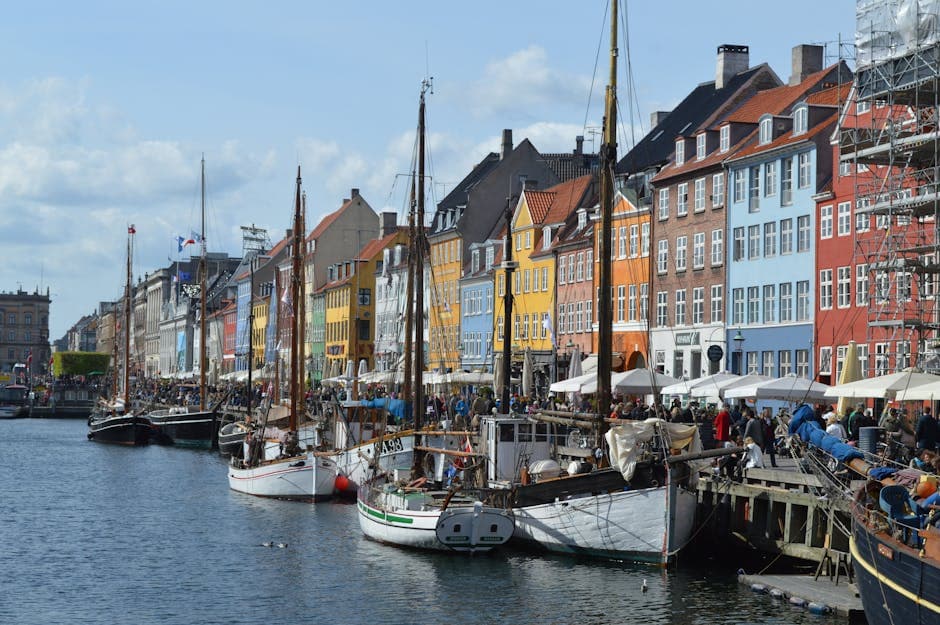Lucas Botzen
Founder & Managing Director
Last updated:
November 28, 2025
What is an Employer of Record in Denmark?
View our Employer of Record servicesAn Employer of Record (EOR) in Denmark legally employs your workers on your behalf. This means the EOR handles all local HR tasks, like payroll, taxes, benefits, and compliance with Danish employment law. You still manage your employee's day-to-day work and responsibilities. An EOR, such as Rivermate, makes it simple to hire employees in Denmark without setting up your own legal entity in the country.
How an Employer of Record (EOR) Works in Denmark
Using an EOR in Denmark simplifies the process of hiring and managing employees. Here is how it typically works:
- You Find the Candidate: You recruit and select the best person for the job.
- The EOR Hires Your Candidate: The EOR legally hires the employee through a local, compliant employment contract.
- Onboarding and HR: The EOR manages all HR administrative tasks. This includes payroll, tax withholdings, and providing statutory benefits.
- You Manage Your Team: You direct your employee's daily tasks and responsibilities, just like any other member of your team.
- Ongoing Compliance: The EOR stays up-to-date with Danish labor laws to ensure your employment relationship remains compliant.
Why use an Employer of Record in Denmark
An EOR offers a straightforward and efficient way to build a team in Denmark. It removes the significant administrative and legal burdens of international hiring. This allows you to focus on growing your business and managing your team.
Here are some key reasons to use an EOR in Denmark:
- Enter the Market Quickly: You can hire employees and start operating in Denmark in a matter of days, not months.
- Avoid Creating a Legal Entity: You do not need to establish a local company or branch office, which saves you time and money.
- Ensure Full Compliance: EORs are experts in Danish employment law. They handle complex regulations, collective agreements, and statutory requirements.
- Simplify HR and Payroll: The EOR manages all payroll, tax, and benefits administration. This frees up your internal resources.
- Offer Competitive Benefits: An EOR can provide your employees with access to comprehensive and locally competitive benefits packages.
Responsibilities of an Employer of Record
As an Employer of Record in Denmark, Rivermate is responsible for:
- Creating and managing the employment contracts
- Running the monthly payroll
- Providing local and global benefits
- Ensuring 100% local compliance
- Providing local HR support
Responsibilities of the company that hires the employee
As the company that hires the employee through the Employer of Record, you are responsible for:
- Day-to-day management of the employee
- Work assignments
- Performance management
- Training and development
Costs of using an Employer of Record in Denmark
Rivermate's transparent pricing model eliminates complexity with a single, competitive monthly fee per employee. Unlike traditional PEO providers, our pricing in Denmark includes comprehensive HR support, benefits administration, compliance management, and access to our proprietary dashboard for real-time workforce analytics. No hidden costs, no setup fees—just straightforward pricing that scales with your business needs while ensuring full legal compliance in Denmark.
Employ top talent in Denmark through our Employer of Record service
Book a call with our EOR experts to learn more about how we can help you in Denmark







Book a call with our EOR experts to learn more about how we can help you in Denmark.
Trusted by more than 1000 companies around the globe
Hiring in Denmark
Hiring in Denmark is straightforward. The country has a transparent business environment and a flexible labor market. You can attract great talent, but be aware that employees in Denmark are used to changing jobs more frequently than in other countries. To keep your team engaged, you need to offer competitive pay and good benefits.
Employment contracts & must-have clauses
You must provide a written employment contract for all employees who work for you for more than one month and for more than an average of eight hours per week. The contract should be in place no later than seven days after the employee starts.
Your employment contract should include these key details:
- Employer and employee details: Names and addresses for both you and your employee.
- Workplace location: The primary place of work.
- Job description: A clear description of the role, including title and responsibilities.
- Start date: The official start date of employment.
- Contract length: State whether the contract is for a fixed term or is permanent.
- Holiday entitlement: Information on paid leave.
- Notice periods: The notice required from both you and the employee for termination.
- Salary and payment: The agreed salary, any other compensation, and how often the employee will be paid.
- Working hours: The standard daily or weekly working hours.
- Collective agreements: Mention any collective bargaining agreements that apply to the role.
Probation periods
You can agree to a probation period with a new employee. For salaried employees, this trial period can be a maximum of three months. During this time, you or the employee can end the contract with 14 days' notice. For other types of workers, the probation period can be up to six months. Any probation period must be clearly stated in the employment contract to be valid.
Working hours & overtime
The standard work week in Denmark is 37 hours, typically spread over five days. While there are no strict statutory rules on standard hours, the average weekly working time, including overtime, cannot exceed 48 hours over a four month period.
Compensation for overtime is usually determined by collective agreements. For employees not covered by these agreements, you should define overtime pay in the individual employment contract. Common practice is to offer either a higher pay rate or time off in lieu of payment for extra hours worked.
Employees are entitled to a rest period of at least 11 consecutive hours in every 24 hour period and one full day off per week.
Public & regional holidays
Employees in Denmark are entitled to paid time off for public holidays. The official public holidays for 2025 are:
| Date | Holiday |
|---|---|
| 1 Jan | New Year's Day |
| 17 Apr | Maundy Thursday |
| 18 Apr | Good Friday |
| 20 Apr | Easter Sunday |
| 21 Apr | Easter Monday |
| 29 May | Ascension Day |
| 8 Jun | Whit Sunday |
| 9 Jun | Whit Monday |
| 25 Dec | Christmas Day |
| 26 Dec | 2nd Day of Christmas |
Some other days, like Constitution Day (5 June), Christmas Eve (24 December), and New Year's Eve (31 December), are not official public holidays, but many workplaces close on these days as part of collective agreements.
Hiring contractors in Denmark
You can hire independent contractors in Denmark for specific projects and specialized skills. This gives you flexibility and can be cost effective since you do not pay for employee benefits, social security, or pensions. Contractors manage their own taxes and work independently, meaning they decide how and when to complete the work.
The main challenge is worker misclassification. If a contractor is deemed to be an employee in everything but name, you could face significant penalties. The distinction depends on factors like control, financial risk, and integration into your company.
An Employer of Record (EOR) can help you avoid this risk. An EOR ensures that your contractors are classified correctly according to Danish law. We handle the contracts and payments, making sure you stay compliant while you focus on managing the work. This protects you from legal and financial trouble down the line.

Compensation and Payroll in Denmark
In Denmark, your payroll is straightforward and digitally driven. The system is built on a foundation of collective agreements and a high degree of trust. This means that while there are rules, there's also a focus on fairness and work-life balance. Most of the administration is handled online, making processes efficient for both you and your employees.
Payroll cycles & wage structure
In Denmark, you'll find that most companies run payroll on a monthly cycle. Payments are typically made on the last working day of the month. While there's no legally mandated payday, this monthly schedule is the standard.
Your employees' wages are usually determined by collective bargaining agreements. These agreements are made between employer associations and trade unions and are very common in Denmark. They set the standards for pay, hours, and working conditions within specific industries.
When you hire an employee, you must provide them with a written contract. This contract outlines all the important details of their employment, including their salary and any benefits.
Overtime & minimums
There is no official government-mandated minimum wage in Denmark. Instead, minimum wage rates are established through collective bargaining agreements in different sectors. The average minimum wage is around 110 DKK per hour.
The standard work week is 37.5 hours. Overtime is also managed through collective agreements. Typically, any hours worked beyond the standard 37 are compensated at a higher rate, often between 150% and 200% of the regular pay. The maximum number of work hours per week, including overtime, is 48.
Employer taxes and contributions
As an employer in Denmark, you are responsible for several contributions. These are generally flat-rate amounts rather than percentages of salary.
| Contribution | Description |
|---|---|
| ATP (Arbejdsmarkedets Tillægspension) | A mandatory supplementary pension scheme. |
| AUB (Arbejdsgivernes Uddannelsesbidrag) | Funds for apprenticeships and vocational training. |
| AES (Arbejdsmarkedets Erhvervssikring) | Contributions for occupational injury and disease insurance. |
| FIB (Finansieringsbidrag) | Covers benefits for maternity, sickness, and parental leave. |
| Holiday Pay | You must contribute 12.5% of an employee's gross salary to a holiday fund. |
Employee taxes and deductions
Employees in Denmark contribute to taxes at both the state and municipal levels. The system is progressive, meaning higher earners pay a larger percentage of their income in taxes.
| Deduction | Description | Rate |
|---|---|---|
| AM-bidrag (Arbejdsmarkedsbidrag) | A labor market contribution that funds social security. | 8% of gross income |
| ATP (Arbejdsmarkedets Tillægspension) | A mandatory supplementary pension scheme. | A fixed annual amount. |
| Municipal Tax | Varies by municipality. | 22.5% to 27.0% |
| State Tax | A progressive tax with two brackets. | Bottom rate of 12.10% and a top rate of 15% for income above a certain threshold. |
| Church Tax (Kirkeskat) | An optional tax for members of the Danish National Church. | Averages around 0.64% |
How an Employer of Record, like Rivermate can help with payroll taxes and compliance in Denmark
An Employer of Record (EOR) manages monthly payroll calculations, employer contributions, and tax filings in-country on your behalf. Rivermate handles registrations, payslips, statutory reporting, and remittances to authorities so you stay compliant with local rules and deadlines—without setting up a local entity. Our specialists monitor regulatory changes and ensure correct rates, thresholds, and caps are applied to every payroll cycle.
Loading calculator...
Benefits and Leave in Denmark
In Denmark, you'll find a strong emphasis on work-life balance, reflected in the generous leave and benefits employees receive. The system is built on the idea that people should have plenty of time for family, leisure, and personal pursuits. This approach helps create a happy, productive, and loyal workforce.
Statutory leave
Danish law provides several types of mandatory leave for employees.
- Annual Leave You get five weeks of paid vacation each year. You earn 2.08 days of leave for every month you work.
- Sick Leave If you get sick, your employer pays your salary for the first 30 days of your absence. After that, you may be eligible for sickness benefits from your local municipality.
- Parental Leave Parents in Denmark are entitled to a total of 52 weeks of leave with benefits to share after the birth of a child. This includes leave specifically for the mother before and after birth, and two weeks for the father or co-mother after the birth.
Public holidays & regional holidays
Denmark has a number of official public holidays. Some other days are not official holidays, but many people have the day off due to collective agreements.
| Date | Holiday | Status |
|---|---|---|
| January 1 | New Year's Day | Public Holiday |
| April 17 | Maundy Thursday | Public Holiday |
| April 18 | Good Friday | Public Holiday |
| April 20 | Easter Sunday | Public Holiday |
| April 21 | Easter Monday | Public Holiday |
| May 29 | Ascension Day | Public Holiday |
| June 5 | Constitution Day | Not a public holiday, but many have the day off |
| June 8 | Whit Sunday | Public Holiday |
| June 9 | Whit Monday | Public Holiday |
| December 24 | Christmas Eve | Not a public holiday, but many have the day off |
| December 25 | Christmas Day | Public Holiday |
| December 26 | Boxing Day | Public Holiday |
Typical supplemental benefits
Beyond the legal requirements, many Danish employers offer extra benefits to attract and retain talent.
| Statutory Benefits | Non-Statutory (Supplemental) Benefits |
|---|---|
| Holiday Pay (12.5% of annual salary) | Private Pension Plans |
| Workers' Compensation Insurance | Private Health Insurance |
| Contributions to the Labour Market Supplementary Pension (ATP) | Flexible Working Hours |
| Paid Sick Leave | Additional Paid Time Off |
| Paid Parental Leave | Company Car or Phone |
| Fitness Memberships or Canteen Facilities |
How an EOR can help with setting up benefits
Setting up a compliant and competitive benefits package in a new country can be complex. An Employer of Record (EOR) simplifies this process for you.
An EOR acts as the legal employer for your team in Denmark. This means they handle all the administrative and legal requirements of employment.
Here is how an EOR can help:
- Compliance They ensure your benefits packages meet all of Denmark's legal requirements.
- Administration An EOR manages the entire benefits administration process, from enrollment to ongoing support.
- Payroll Integration They integrate benefits contributions directly into the payroll system, ensuring accurate deductions and payments.
- Expertise You get access to local experts who understand the Danish market and what benefits are most attractive to employees.
- Speed An EOR allows you to hire and onboard employees in Denmark quickly, without needing to set up your own legal entity.
By handling the complexities of benefits and compliance, an EOR frees you up to focus on growing your business and managing your team.
How an Employer of Record, like Rivermate can help with local benefits in Denmark
Rivermate provides compliant, locally competitive benefits—such as health insurance, pension, and statutory coverages—integrated into one EOR platform. We administer enrollments, manage renewals, and ensure contributions and withholdings meet country requirements so your team receives the right benefits without added overhead.
Termination and Offboarding in Denmark
Letting an employee go in Denmark involves clear steps and legal requirements. You need a valid reason for termination, especially if the employee has been with you for over a year. Reasons can include the employee's conduct or changes within your company. The process is designed to be fair to both you and your employee.
Notice periods
When you terminate an employment contract in Denmark, the notice period depends on how long the employee has worked for your company. These rules are part of the Danish Salaried Employees Act.
Here is a breakdown of the minimum notice periods you must provide:
| Employee's Tenure | Employer's Notice Period |
|---|---|
| 0 to 6 months | 1 month |
| 6 months to 3 years | 3 months |
| 3 to 6 years | 4 months |
| 6 to 9 years | 5 months |
| More than 9 years | 6 months |
Employees who wish to resign generally need to give one month's notice.
Severance pay
In Denmark, severance pay is a right for long-term employees. An employee is entitled to severance pay if they have worked for the same company for at least 12 years.
- 12 to 17 years of employment: The employee receives one month's salary as severance pay.
- More than 17 years of employment: The severance pay increases to three months' salary.
This payment is in addition to their regular salary during the notice period.
How Rivermate handles compliant exits
When you partner with an Employer of Record like Rivermate, we manage the entire termination process for you. We ensure that every step complies with Danish labor laws. This saves you time and reduces the risk of legal issues.
Our process includes:
- Ensuring legal compliance: We handle all the legal requirements for termination, including notice periods and severance pay.
- Managing documentation: We prepare and manage all necessary paperwork for a compliant exit.
- Providing local expertise: Our team understands the details of Danish employment law, so you can navigate the process with confidence.
Visa and work permits in Denmark
Navigating the world of visas and work permits in Denmark is straightforward when you understand the rules. For anyone outside the Nordic countries, the EU, EEA, or Switzerland, a residence and work permit is necessary before starting a job. The process is managed by the Danish Agency for International Recruitment and Integration (SIRI). Denmark offers several pathways to employment, with the most common being the Pay Limit Scheme for higher earners and the Positive List for professions facing skilled worker shortages. Processing times for work permits are relatively quick, typically taking about one to two months.
Employment visas & sponsorship realities
An Employer of Record (EOR) can sponsor work permits for foreign employees in Denmark. This is a practical solution if your company is not a registered legal entity in the country. The EOR acts as the official employer, handling the necessary paperwork and ensuring compliance with Danish immigration laws.
Here are the key routes for employment sponsorship:
- Pay Limit Scheme: This is the most direct path for high-earning professionals. If you have a job offer with a salary that meets or exceeds the minimum threshold, you are eligible. The scheme does not require a specific educational background or field of work.
- Positive List: This route is for professionals in fields where Denmark has a shortage of qualified workers, such as engineering and medicine. You must have a job offer in one of the listed professions to qualify.
- Fast-Track Scheme: Available to companies certified by SIRI, this scheme offers a quicker path to obtaining work permits for qualified employees. It allows for a more flexible process and is ideal for businesses that need to bring in international talent quickly.
An EOR cannot sponsor independent contractors or freelancers for these work permits; these routes are for employees with a formal job offer.
Business travel compliance
You can travel to Denmark for short-term business without a work permit. Denmark is part of the Schengen Area, which allows for business-related activities for up to 90 days within a 180-day period.
Permitted activities include:
- Attending business meetings with colleagues or clients.
- Negotiating contracts.
- Participating in training.
It is important to note that a Schengen business visa does not permit you to work. Working is defined as contributing to a company's output or modifying a product.
There are specific exemptions for employees of affiliated companies. If your company has a branch or affiliate in Denmark with at least 50 employees, you may be able to work for short periods without a permit under new rules.
| Duration of Work | Requirement |
|---|---|
| Up to 15 working days | No work permit needed if employed by an affiliated company. |
| Two separate periods within 180 days | A break of at least 14 days between visits is required. |
Always be clear about the purpose of your visit in your visa application to avoid issues. If your activities might be considered work, it is best to seek clarification from the Danish authorities.
How an Employer of Record, like Rivermate can help with work permits in Denmark
Navigating work permits can be complex and time‑sensitive. Rivermate coordinates the entire process end‑to‑end: determining the right visa category, preparing employer and employee documentation, liaising with local authorities, and ensuring full compliance with country‑specific rules. Our in‑country experts accelerate timelines, minimize refusals, and keep you updated on each milestone so your hire can start on time—legally and confidently.
Frequently asked questions about EOR in Denmark
About the author

Lucas Botzen
Lucas Botzen is the founder of Rivermate, a global HR platform specializing in international payroll, compliance, and benefits management for remote companies. He previously co-founded and successfully exited Boloo, scaling it to over €2 million in annual revenue. Lucas is passionate about technology, automation, and remote work, advocating for innovative digital solutions that streamline global employment.
